Trekking Tours
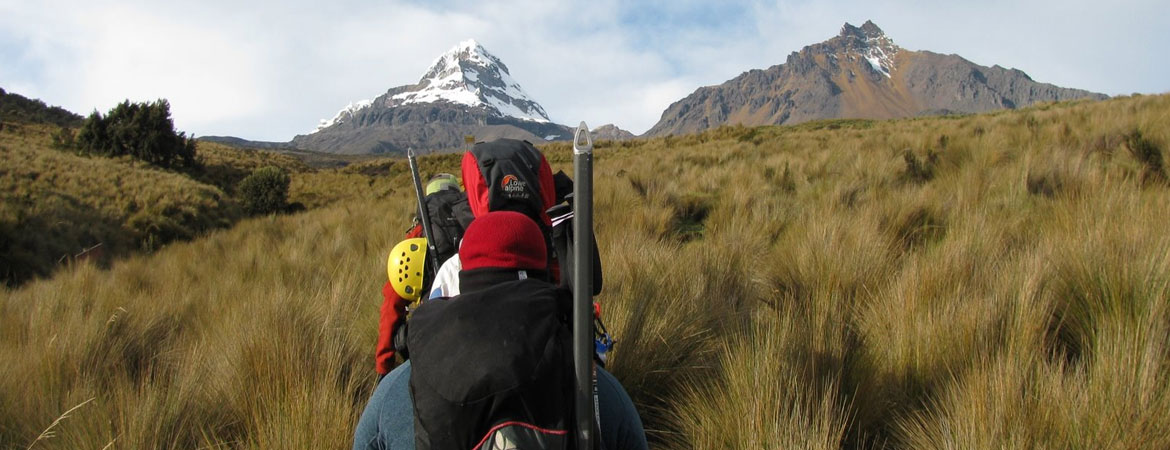

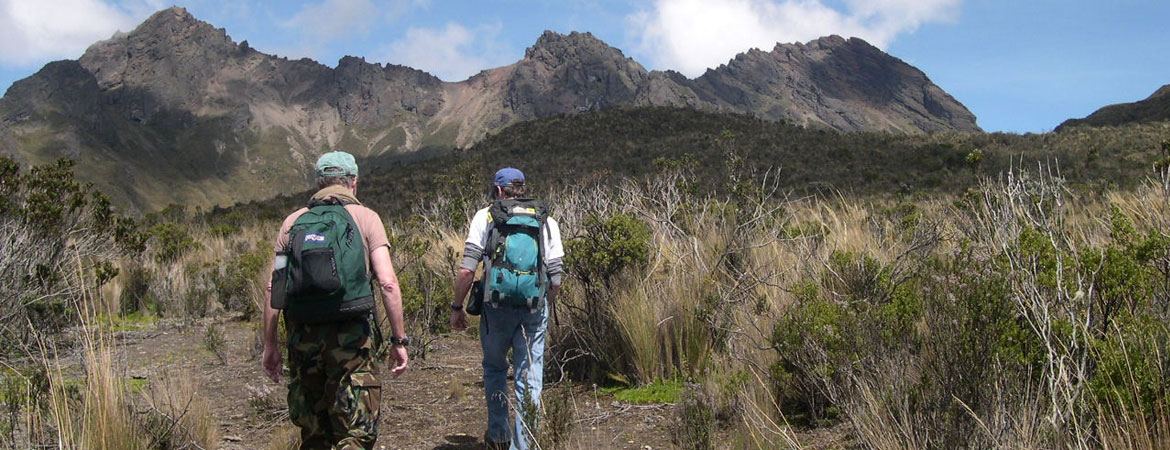
Choose from a low difficult trek through the plantations of the northern Andes, or a more treacherous trek the summit of one of the many volcanoes throughout the country. Trekking tours offer you a way to not only see, but fully experience the wonderful scenery of Ecuador. Become one with nature as you trek to see our many volcanoes, lakes, rivers, and farms!

All routes start on a common trail, which goes through a bamboo area, first drop and cross Quebrada Santa Ana on a small wooden bridge, then it climbs gradually along a well maintained trail to a more open area, pastures and paramo.
The trail now climbs steeply east onto a ridge, at the crest of Runduloma (3450mts) with a forest of Polylepis three of them continue to the cliff where the summit of this hike will be and the way down, which once made a loop.
- Rating: Easy 13 Km (8 miles) 6 hours full day walk
- Elevation: 2800 to 3590 meters 9200 to 13500 feet
- Best time to visit: All year around except April
- Special gear: None
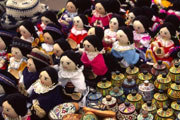
Full day
Pasochoa is an extinct volcano located 30 Km south of Quito, it’s believed to have last erupted about 100.000 years ago, when the west side of his crater collapsed, resulting in its current horseshoe shape.
Pasochoa can be climbed from various directions. In clear weather the slopes of Pasochoa offer fine views of many majestic summits like Cayambe, Antisana, Sincholagua, Ruminahui.
Pasochoa is a particularly good acclimatization hike in preparation for more strenuous, high altitude trekking.
- Rating: Easy 9 Km Full day hike
- Elevation: 3300 to m4200 meters 10.800 to 13.800feet
- Best time to visit: All year around except April the temperature can drop suddenly, and dense fogs roll in at any time of the year
- Special gear: None

Full day
Ruminahui is another impressive volcano with several rocky peaks, the highest rising to 4722 meters (15.943feet). A huge ancient eruption destroyed Ruminahui’s cone, leaving a particularly craggy mountain. Ruminahui means stone face and is named by Incan Emperor Atahualpa’s loyal general. According to legend, after hiding Atahualpa’s treasure in the Llanganates, Ruminahui found shelter at the foot of the mountain that now bears his name and from here continued his resistance against the Spanish conquerors
- Rating: Moderately difficult, 20km (12.5mile) 2 day trek
- Elevation: 3000 to 4200 meters 9850 to 14500 feet
- Best time to visit: All year around except April and May
- Special gear: Hiking boots

The trek of Antisana is classical Paramo hike with excellent views of snow capped volcanoes and a chance to see and endangered Andean Condor.
We hike through Antisana Ecological reserve one of the most expectacular highlands park in Ecuador and Americas.
The Paramo of Antisana is more diverse than anything else in the world flowering Puya plants more than 25 feet high, Orchids, Fraylejones, animals such as Andean fox, Mountain Tapir, etc.
- Rating: Easy 8 miles
- Elevation: 3500 to 4200 meters 11000 to 14500 feet
- Best time to visit: All year around
- Special gear: hiking boots, warm clothing.

Otavalo provides ample opportunities for trekking. Among the most frequently visited spots are the Summit of Mountain Imbabura, The Mojanda Lakes at the south west Mojanda Volcano to Cota - Cachi Volcano hike, San Pablo to Zuleta hacienda.
Cuy- Cocha Hike
Is one of the most scenic lakes in Ecuador situated at the northern slope of a Volcano call Cotacachi (active) 4939 meters The Lake fills a volcanic caldera. About 1000 years ago an explosive eruption emptied the underlying magma chambers, so the bulk of the original mountain fell in on itself .
It is an easy and popular day hike, with simple access west of Otavalo and pretty views of mountains, valleys and the lake.
All this hike is located at the Chocó corridor; rewarding route offer a wonderful diversity of endemic flora and fauna as well as a glimpse of the homesteader`s way of life.
- Rating: Easy 7.5mile full day hike
- Elevation: 3050 to 3450 meters (10.000 to 11.500 feet)
- Special gear: None
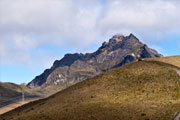
Full day
Guagua and Rucu Pichincha, 4,776 m (15,670 ft) and 4,627 m (15,180 ft) respectively, are two volcanoes located about 10 km (6 miles) west of Quito. Guagua, which means “baby” in the Quichua language, is higher than its neighbor and currently active – it covered the Ecuadorian capital with ash in 1999. Rucu, meaning “old”, is slightly lower and closer to Quito.
Hiking Rucu Pichincha
The hike from Cruz Loma to Rucu’s peak consists of a one and a half hour walk along a grassy ridge that steadily rises towards a rocky base beneath the summit. Once you reach the rock, you can either go right and hike the cliff until you reach a sandy slope that leads to the summit or go straight up the rock. Both of these routes require an additional one and half hours. The second option should not be attempted by inexperienced climbers unless they are accompanied by a guide equipped with ropes and harnesses.
Guagua Pichincha
Is best accessed from Lloa, a village located south of the two volcanoes.
Hiking Guagua Pichincha
If you decide to hike all the way from the village to the crater, head west out of town and follow a meandering road up to the refuge. It takes between five and six hours of steady walking. From the refuge, there is a clear trail to the crater. It was once possible to walk down into the crater; however since the eruption of Guagua Pichincha in 1999 and the possibility of renewed emissions of noxious volcanic gases, this is not recommended.

Full day
Only a short trip from Quito, Cotopaxi National Park is one of the most impressive national parks in Ecuador, and it contains the famed Cotopaxi Volcano. The ecological reserve surrounds the volcano, located on the border between the provinces of Pichincha and Cotopaxi. The national park is particularly interesting because the volcano suddenly surges out of relatively flat terrain, offering spectacular views of the volcano from all directions.
Cotopaxi National Park is a popular destination for visitors looking to hike, climb and trek, as well as those seeking to enjoy stunning panoramas from down below. Cotopaxi's ecosystem is home to a wide variety of flora and fauna, including a unique combination of pine vegetation and wolves, pumas, bears, rabbits, condors, wild horses, and foxes.
Cotopaxi Facts & Statistics
- Second highest peak in Ecuador, after Chimborazo
- Elevation of peak: 5.897 m
- Last eruption: 1904, with activity registered in 1942
- Nearest cities: Quito, Latacunga
- Native fauna: wolves, pumas, bears, rabbits, condors, wild horses, and foxes
Cotopaxi Climate & Mountaineering
Cotopaxi is one of the most popular climbing sites in Ecuador. Cotopaxi is the second highest point in Ecuador and at 5,897 meters above sea level, its climate is glacial. It is absolutely essential to have adequate mountaineering gear when you embark.
Be sure to check with a professional guide and see our packing list for packing advice. For those seeking to reach the summit, a professional mountaineering guide is strongly recommended. The most common route is from the refuge at 4800m on north side of the volcano.
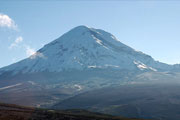
Four days
Day 1: Early morning departure traveling south via the Volcanoes Avenue toward Mochapata. We´ll visit Ambato with its typical markets and the Salasacas market as well. We´ll set up our first basecamp at Mochapata town. Box lunch and dinner included
Day 2: Our first hike will be around the upper perimeter of Chimborazo (Ecuador's highest peak 20.634 feet). Trekking toward Mocha's river right in between of Carihuairazo and Chimborazo volcanoes we´ll set up our next basecamp (Abraspungo). Breakfast, box lunch and dinner included.
Day 3: We´ll visit the Vicuñas Project. The main purpose of this project is to preserve the endemic species of the Andean ecosystem (alpacas, llamas, and vicuñas). We´ll set up our next campsite in this protected area. Breakfast, box lunch and dinner included.
Day 4: Morning treks around the Vicuñas Project toward a place known as "Quebrada Colorada" or we can climb up to the first refugee of Chimborazo depending on our visitors request. Breakfast and box lunch included. Late afternoon break camp and drive back to Quito.
Includes:
- Transfers Hotel-Tour-Hotel
- Private transportation
- Camping equipment
- All specified meals above
- All non alcoholic beverages
- Bilingual Naturalist Guide
Does not include:
- Sleeping bags
- Tips, extras
- Items not hereby specified
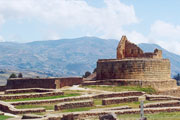
Eight days
The Inca Empire extended from the northern part of Chile to the southern part of Colombia was connected by a well-maintained system of roads that still preserves its functionality. This beautiful trek will give you a great sample of Andean rural life with a few changes in the last centuries.
Day 1: Transfer in Arrival to the Hotel.
Day 2: Full day in Quito.
You’ll have a brief information of the Inca Empire while visiting the colonial part of Quito, its museums and churches; the Equator line and the Central Bank museum with its fine collection of Pre-Colombian art. Overnight at the hotel. Box lunch or lunch and dinner included.
Day 3: From Quito to Riobamba.
We will visit the Cotopaxi National Park and also we’ll hike along the Paramo area; during the afternoon we’ll go to the Hotel in Riobamba. Breakfast, box lunch and dinner included.
Day 4: From Riobamba to Achupallas.
After breakfast will take the train that goes from Riobamba to Chan-Chan.
On our way we’ll see the mountain called The Devil Nose. During the afternoon will go to Achupallas, our first campsite, at 10.000 feet. This is one of the sites with more historical richness in the area. Breakfast, box lunch and dinner included.
Day 5: From Achupallas to Tres Cruces Lake.
Early in the morning will pack our gear on the horses and we’ll start hiking up to the Inca trail at 12.000 feet. The trip will take us 6 hours to arrive to our next camp. All along the way we will have the opportunity to see different types of flora and fauna of the Andean Paramo. Breakfast, box lunch and dinner included.
Day 6: From Tres Cruces Lake to Paredones.
After breakfast, we will start hiking toward Tres Cruces Lake, at 13.760 feet; then we’ll walk along the ridge of Huagrarumi surrounded by beautiful views of the lakes of the area. (5 to 6 hours hike to our camp
which will be located at 10.500 feet).
Breakfast, box lunch and dinner included.
Day 7: From Paredones to Ingapirca –Cuenca.
We’ll continue our trek along the Inca trail to Ingapirca that means Inca StoneWall and was built on top of an old Canari settlement (principal indigenous group of all southern Ecuador) on the Royal Road. We will be able to see a great variety of birds, such as caracaras, cincloides, hawks, etc.- As we approach Ingapirca, crossing fields of potatoes, barley, onions, etc will see the ruins from a farther position. During the afternoon we will visit the ruins and the museum; later on we’ll drive back to Cuenca. Overnight at the hotel. Breakfast, box lunch and dinner included.
Day 8: Cuenca- Quit.
We will finish our tour with a shopping day in Cuenca and in the late afternoon we will fly back to Quito. Breakfast and lunch included
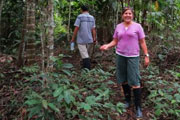
Eleven days
A fascinating walking expedition to discover one of the most remote and mysterious Amazon rainforest. We travel 90 km through the jungle guided by natives of the Cofan Community. Sharing sleep in camps home to sloths, tapirs, anacondas, river dolphins.
Our adventure starts in Quito, a city in which visit its main attractions.
Then fly from Quito to Lago Agrio and head to the town of Chiritza. From here our adventure begins as we sail on board a motorized canoe down the river Aguarico to reach the river Zabalo Cofan population. From here we will go about 90 km deep into the heart of the Amazon rainforest accompanied by naturalist bilingual guides who know the region will be aeble to show their culture and way of life of the indian comunities.
Overnight in camps built with local materials, with roofs of palm leaves and wooden floor. Tents inside
The jungle hikes require good physical condition (due to heat and humidity) but every traveler need only carry their own backpack with the team for the day as the rest of the luggage will be transported by porters from the local community.
Day 1: arrive to Quito.
Patio Andaluz Hotel or similar, located in the heart of the ancient city of Quito, declared a World Heritage Site by UNESCO in 1978. The hotel is conveniently located near the central plaza, near churches, museums and national monuments. Welcome Cocktail, rest of the day free and overnight at the hotel.
Day 3: Quito.
Today we will explore the colonial center of Quito starting the convent of San Agustín. Its Colonial patio, cloisters, coffered ceilings and a large collection of paintings, we will unveil the life of St. Augustine. Visit the Plaza de la Independencia, the Presidential Palace, the Municipal Building and the Archbishop's Palace. Continue to the Church of San Francisco, one of the most beautiful religious buildings in the New World. Its impressive façade and atrium that will lead us inside its gilded Baroque influence in the Moorish style, with its winged Virgin of Quito and its main altar. Then we head north to the modern part of Quito, the park "La Carolina" to visit the Botanical Garden of Quito where you can appreciate the great diversity of flora in Ecuador. Accommodation.
Day 4: Quito - Lago Agrio - Cofan Community Zabalo.
In the morning we fly from Quito to Lago Agrio and head to the town of Chiritza on a journey of about an hour and a half by bus. From here we sail on board a motorized canoe down the river Aguarico. After an interesting three-hour trip down the river, get to the Cofan population Zabalo River, where we expect a nice dinner and stayed in huts typical of the Amazon.
Day 5: Canoe ride along the river Zabalo Motor.
In the morning we continue our sailing by motor canoe and go interned by the river Zabalo. Countless species of birds live here, for example: hoatzins, parrots, caciques, orioles and Anning. Also we can see howler monkeys and see herds of javelina. Lunch in the jungle, and after a walk through the woods, we began the paddle back downstream and appreciate the animal life in complete silence. Zabalo back to camp, accommodation and dinner.
Day 6: Camp Cofán - Patisacco.
We leave the camp in the morning and start our journey through the jungle. The Cofan guide will show you a complete range of plants and will explain how and why they use the native. Afternoon arrival at the second camp in Patisacco. If you still are with energy, we take a trip to discover the area with a native guide. If you prefer to rest at the camp, we can see different species of birds in the environment. Dinner and overnight.
Day 7: Patisacco - Rio Lagarto.
Continue through the rainforest to camp Alligator River, which is an entrance to the river of the same name. Here we give a relaxing bath in its calm waters, and hopefully see some tapirs or some other wild animal that inhabits the area. In the evening walk along the river banks to watch the alligators intriguing. Dinner and overnight.
Day 8: Rio Lagarto - Camp Fensijapa.
Continue through the bank and move on to the camp Fensijapa. Along the way, we observe the animals probably hiding in the dense vegetation. In addition to the flooded areas of forest that visit, we encounter in less visible places a lot of micro fauna, which makes the Ecuadorian jungle one of the most biodiverse in the world. The suspension bridge near the camp marks the best place to enjoy a swim around the ride. In the evening we will hear a concert by the inhabitants of the jungle night. Dinner and overnight.
Day 9: Camp Fensijapa.
From the camp we Fensijapa excellent opportunities for bird watching. Dae accompanied our native guide will dry forest treks and also by the flooded forest where we can see the differences and diversity of the Amazonian world. Those who wish can climb the observation tower embedded in the canopy of ancient trees. Dinner and overnight.
Day 10: Camp Fensijapa - River Zabalo.
Today we will walk along a ridge and can see many times and caíes woolly monkeys. With our guide Cofan cunning attempt to imitate the animals of the jungle to reach out and to observe them, the monkeys, the Cayman, a Quetzal, etc. Subsequently, a Motor boat will pick us up and return to the Commonwealth of Zabalo where we can take a bath and buy some crafts in the community store in the forest made with materials that are treated in a sustainable manner. Dinner and overnight.
Day 11: Lago Agrio - Quito.
Early morning sail up the river and we head to the airport in Lago Agrio to catch the flight back to Quito.


